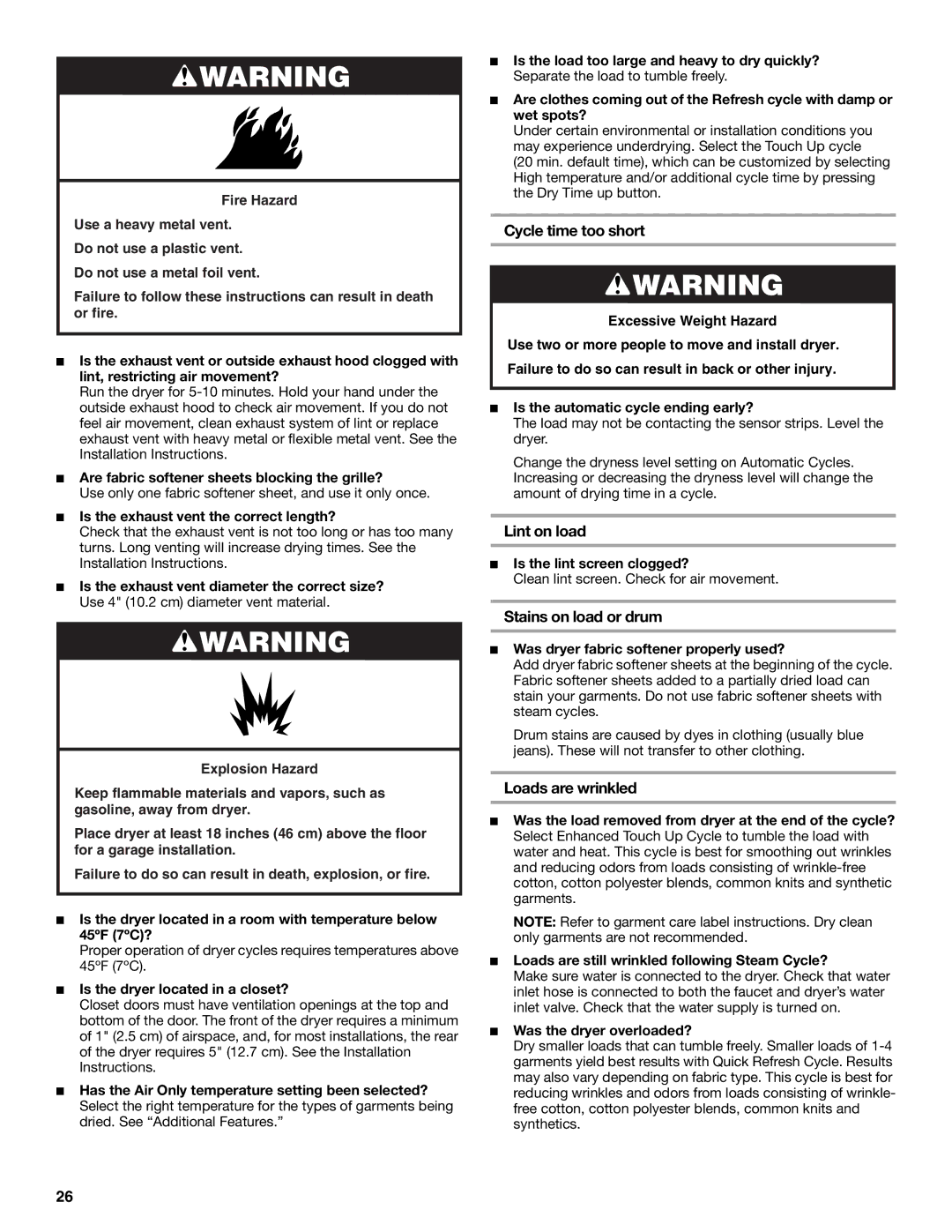
![]() WARNING
WARNING
Fire Hazard
Use a heavy metal vent.
Do not use a plastic vent.
Do not use a metal foil vent.
Failure to follow these instructions can result in death or fire.
■Is the exhaust vent or outside exhaust hood clogged with lint, restricting air movement?
Run the dryer for
■Are fabric softener sheets blocking the grille?
Use only one fabric softener sheet, and use it only once.
■Is the exhaust vent the correct length?
Check that the exhaust vent is not too long or has too many turns. Long venting will increase drying times. See the Installation Instructions.
■Is the exhaust vent diameter the correct size? Use 4" (10.2 cm) diameter vent material.
![]() WARNING
WARNING
Explosion Hazard
Keep flammable materials and vapors, such as gasoline, away from dryer.
Place dryer at least 18 inches (46 cm) above the floor for a garage installation.
Failure to do so can result in death, explosion, or fire.
■Is the dryer located in a room with temperature below 45ºF (7ºC)?
Proper operation of dryer cycles requires temperatures above 45ºF (7ºC).
■Is the dryer located in a closet?
Closet doors must have ventilation openings at the top and bottom of the door. The front of the dryer requires a minimum of 1" (2.5 cm) of airspace, and, for most installations, the rear of the dryer requires 5" (12.7 cm). See the Installation Instructions.
■Has the Air Only temperature setting been selected? Select the right temperature for the types of garments being dried. See “Additional Features.”
■Is the load too large and heavy to dry quickly? Separate the load to tumble freely.
■Are clothes coming out of the Refresh cycle with damp or wet spots?
Under certain environmental or installation conditions you may experience underdrying. Select the Touch Up cycle
(20 min. default time), which can be customized by selecting High temperature and/or additional cycle time by pressing the Dry Time up button.
Cycle time too short
![]() WARNING
WARNING
Excessive Weight Hazard
Use two or more people to move and install dryer. Failure to do so can result in back or other injury.
■Is the automatic cycle ending early?
The load may not be contacting the sensor strips. Level the dryer.
Change the dryness level setting on Automatic Cycles. Increasing or decreasing the dryness level will change the amount of drying time in a cycle.
Lint on load
■Is the lint screen clogged?
Clean lint screen. Check for air movement.
Stains on load or drum
■Was dryer fabric softener properly used?
Add dryer fabric softener sheets at the beginning of the cycle. Fabric softener sheets added to a partially dried load can stain your garments. Do not use fabric softener sheets with steam cycles.
Drum stains are caused by dyes in clothing (usually blue jeans). These will not transfer to other clothing.
Loads are wrinkled
■Was the load removed from dryer at the end of the cycle? Select Enhanced Touch Up Cycle to tumble the load with water and heat. This cycle is best for smoothing out wrinkles and reducing odors from loads consisting of
NOTE: Refer to garment care label instructions. Dry clean only garments are not recommended.
■Loads are still wrinkled following Steam Cycle?
Make sure water is connected to the dryer. Check that water inlet hose is connected to both the faucet and dryer’s water inlet valve. Check that the water supply is turned on.
■Was the dryer overloaded?
Dry smaller loads that can tumble freely. Smaller loads of
26
